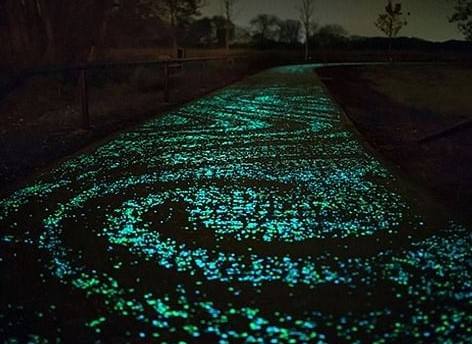
Over the past decade scientists and researchers have been developing more reliable, energy-efficient light-emitting construction products. Examples include a light-generating cement developed at the Michoacan University of Saint Nicholas of Hidalgo (MUSNH) in Mexico by Dr. José Carlos Rubio Ávalos.
It works by absorbing solar energy during the day and irradiating light energy at night. Dr. Avalos discovered that by altering the fine structure of cement he could design a variety that appears to glow in the dark. The cement’s light emitting capability is obtained through a process of polycondensation of the raw materials (silica, river sand, industrial waste, alkali, and water).
The cement is manufactured at room temperature and the process is not energy intensive. As well as being more environmentally-friendly to produce, there is little resultant pollution when compared to other types of cement, such as Portland or synthetic plastics. The cement is available in blue or green colours and the glow can be controlled to avoid glare. Dr. Avalos is also working on cement that can glow white, red and purple.
The material can also be charged using artificial light, and it is hoped that it will be able to offer thermal functions in order to reduce energy consumption. MUSNH obtained the first patent for the cement in 2016.
Initially the material was used in highways, illuminating the road and removing the need for as much street-lighting. The cement also helps solve the problem of how to light typically dark areas such as parking lots, improving safety as well as continual illumination.
In the Netherlands, it has been used for a bicycle lane, built using phosphorescent tiles. Inspired in Van Gogh’s Starry Night, it lights a cyclist’s path and is an alternative to traditional street lighting.

Using the cement in a tile form on a sun-exposed wall can provide enough illumination to light up a space. It also ensures better visibility for security and surveillance. The material can also play a role in the restoration and renovation of urban areas.
The cement has potential to be used in more sustainable buildings and cities in future, such as to light footpaths, swimming pools, interior rooms, and roadways, etc. However, the process to give the cement its light-emitting capability changes the structure of the cement, meaning it can be used only for surface coatings.
Advantages and disadvantages of light generating cement:
Advantages:
- The material is sustainable since it is formed by condensation of silicates usually found in clay, sand, or dust
- The process is ecofriendly as the only gas released during manufacturing is water vapor
- The cement is said to have a life span of 100 years and is being fabricated to emit green or blue light
- The cement has the power to remain lit for about 12 hours after dark
- The level of brightness can be adjusted during production
- The cement is inorganic, and its material components are recyclable
- It could reduce the overhead costs of decorating homes.
Disadvantages:
- Cement is an opaque body that does not allow light to pass into its interior
- Although it is manufactured like ordinary cement, the change in the microscopic structure needed to make it glow modifies the structural properties of the material. It may not have the same applications as the ordinary cement and is intended to be used on surfaces as a coating material.
Sources:
- The future of smart cement
- Alternative materials – light generating cement
- Light emitting cement for smart constructions
- Looking to light highways with light-emitting cement
- Fluorescent cement can illuminate highways sustainably
- Glow in the dark cement
- New light-emitting cement could revamp highway construction
- Glow-hard: Luminous cement could light roads, structures














